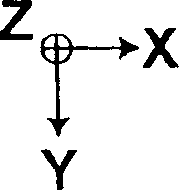Laser multiplex transmission apparatus
A multi-channel transmission and laser technology, which is applied in the direction of lasers, transmission systems, mechanical equipment, etc., can solve the problems of difficult optical multi-channel transmission of beams, reduction of coupling efficiency of beams to optical fibers, etc., and achieve the effect of high transmittance
- Summary
- Abstract
- Description
- Claims
- Application Information
AI Technical Summary
Problems solved by technology
Method used
Image
Examples
Embodiment Ex1
[0144] Figure 10A and Figure 10B A schematic configuration diagram showing the laser multiplexing device 101 according to Embodiment Ex1. Figure 10A is a plan view of the laser multiplexing device 101 . Figure 10B is a front view of the laser multiplexing device 101 . Figure 11 is a perspective view of a prism used in a beam rearrangement optical system.
[0145] The laser multiplexing apparatus 101 of Embodiment Ex1 includes: a laser block 111B' on which five semiconductor lasers are provided; a collimating optical system 111C; a beam rearranging optical system 111R; a converging optical system 111F;
[0146] It should be noted that, as described above, the light beams emitted by the five semiconductor lasers on the laser block 111B have an emission width Ds of 25 μm in the direction of the slow axis. The focal length of the converging optical system 111F is 30 mm in the fast axis direction and 2.85 mm in the slow axis direction. The core diameter of the optical fib...
Embodiment Ex2
[0153] Figure 12A and Figure 12B A schematic configuration diagram showing the laser multiplexing device 102 according to Embodiment Ex2. FIG. 12A is a plan view of the laser multiplexing device 102 . Figure 12B is a front view of the laser multiplexing device 102 . Figure 13 is a perspective view of a prism used in a beam rearrangement optical system.
[0154] The laser multiplexing apparatus 102 of Embodiment Ex1 includes: a laser block 112B′ on which five semiconductor lasers emitting light beams in the −Y direction are provided; a collimating optical system 112C; a beam rearranging optical system 112R; a converging optical system 112F ; and optical fiber 112L.
[0155] It should be noted that, as described above, the light beams emitted by the five semiconductor lasers on the laser block 112B have an emission width Ds of 25 μm in the direction of the slow axis. The focal length of the converging optical system 112F is 30 mm in the fast axis direction and 2.85 mm in ...
Embodiment Ex3
[0162] FIG. 14A and FIG. 14B show a schematic configuration of a laser multiplexing device 103 according to Embodiment Ex3. FIG. 14A is a plan view of the laser multiplexing device 103 . FIG. 14B is a front view of the laser multiplexing device 103 .
[0163] The laser multiplexing device 103 of Embodiment Ex3 includes: a laser block 113B provided with ten semiconductor lasers emitting light beams in the +Z direction; a collimating optical system 113C; a beam rearranging optical system 113R; a converging optical system 113F; and Fiber 113L.
[0164] It should be noted that the emission width Ds in the direction of the slow axis of the light beams emitted by the ten semiconductor lasers on the laser block 113B is 30 μm as described above. The focal length of the converging optical system 113F is 60 mm in the fast axis direction and 2.85 mm in the slow axis direction. The core diameter of the optical fiber 113L is 60 μm.
[0165] The beam rearranging optical system 113R incl...
PUM
 Login to View More
Login to View More Abstract
Description
Claims
Application Information
 Login to View More
Login to View More - R&D
- Intellectual Property
- Life Sciences
- Materials
- Tech Scout
- Unparalleled Data Quality
- Higher Quality Content
- 60% Fewer Hallucinations
Browse by: Latest US Patents, China's latest patents, Technical Efficacy Thesaurus, Application Domain, Technology Topic, Popular Technical Reports.
© 2025 PatSnap. All rights reserved.Legal|Privacy policy|Modern Slavery Act Transparency Statement|Sitemap|About US| Contact US: help@patsnap.com



